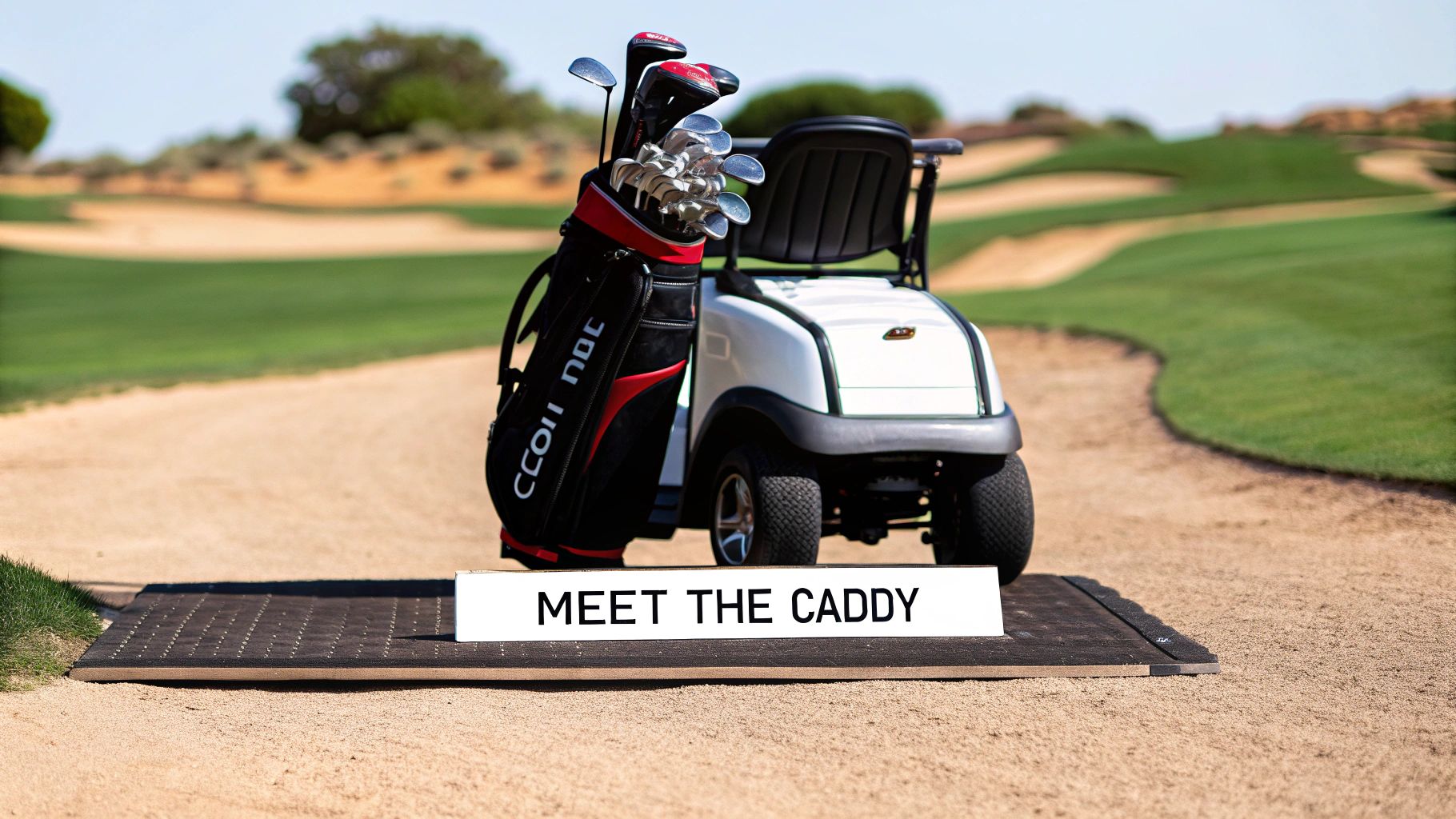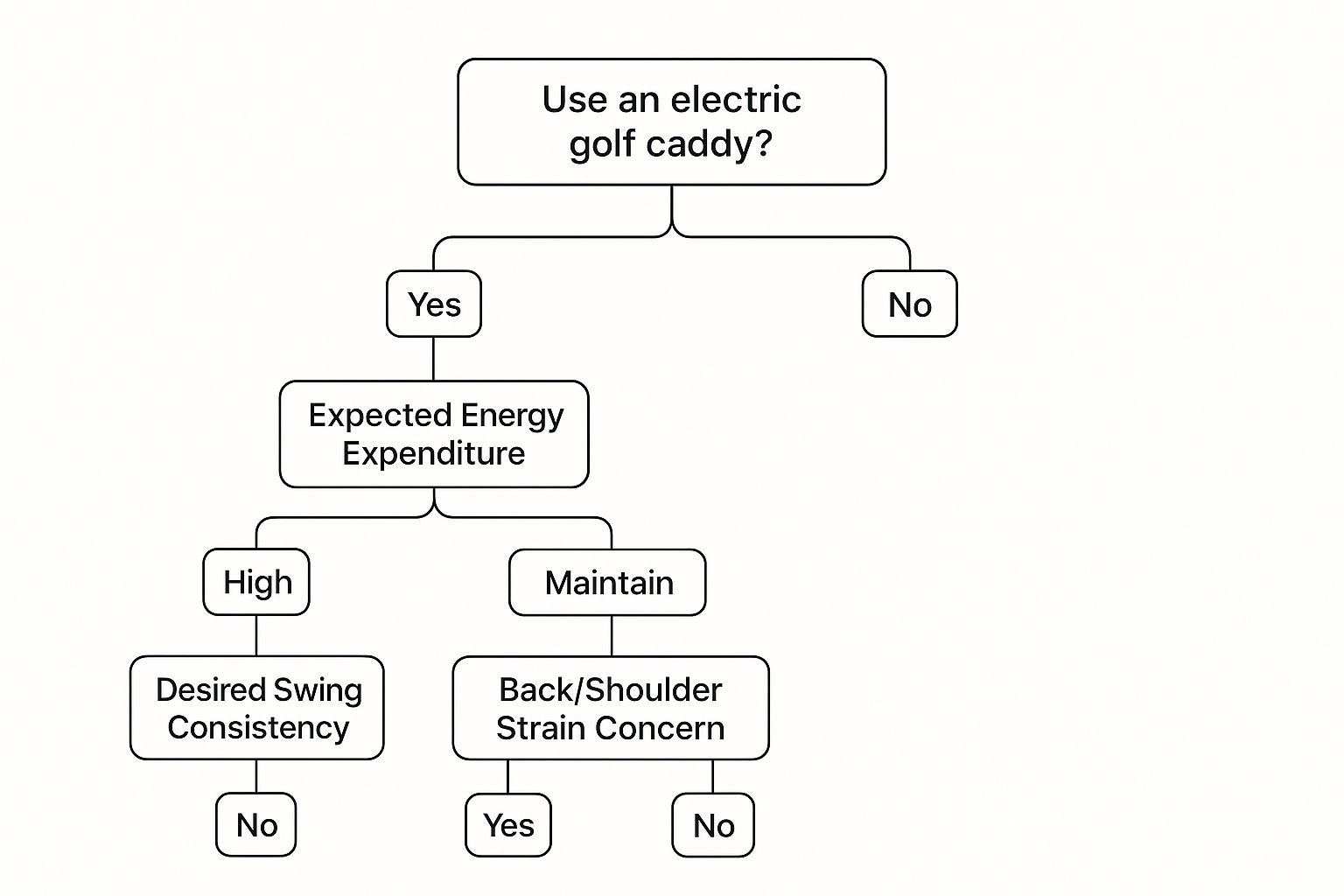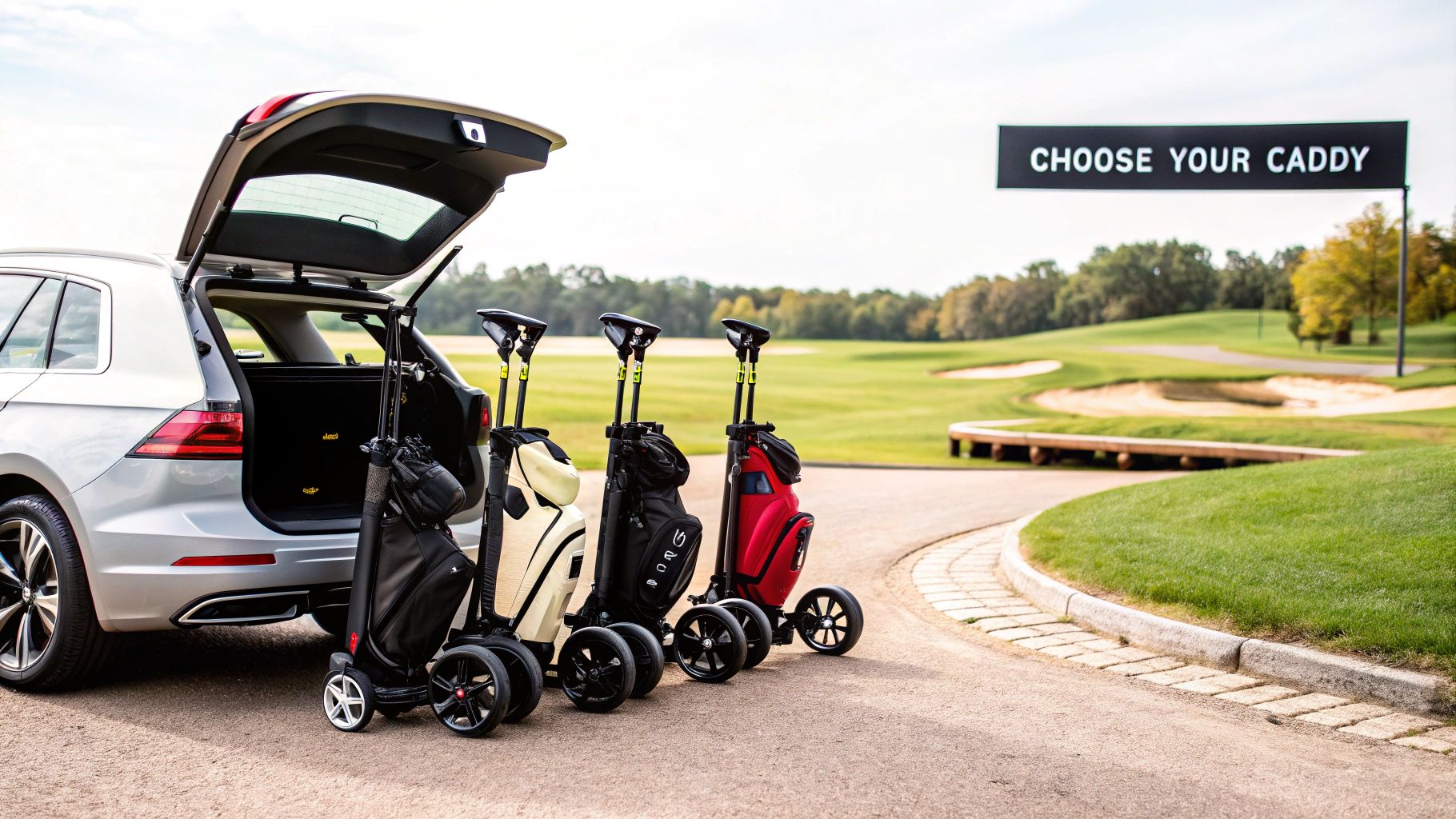At its core, an electric golf cart caddy is just a motorized push cart that handles the heavy lifting of your clubs. This lets you walk the course without the physical drag, freeing you up to focus on what really matters: your next shot.
Walk the Course Smarter, Not Harder

Picture this: you’re stepping onto the 16th tee, feeling just as fresh and strong as you did on the first hole. For most of us, that’s not reality. Hauling a 30-pound bag over miles of fairway slowly drains your stamina, and it almost always catches up to you on the back nine.
This slow burn of energy messes with your swing mechanics, clouds your judgment, and can turn a beautiful walk into a grueling chore. By the time you reach those crucial finishing holes, your body is tired and your focus is shot. Instead of plotting your next move, you’re just trying to make it to the clubhouse.
The Modern Solution to On-Course Fatigue
This is exactly where an electric golf cart caddy changes the entire dynamic of a round. It’s not about skipping the exercise; it’s about ditching the one part of walking that actively hurts your game. Think of it as your personal assistant, tasked with handling the grunt work.
With this single piece of gear, you can:
- Conserve Vital Energy: You save every ounce of strength for your swing, not for dragging your clubs up another hill.
- Maintain Laser Focus: With the burden of your bag gone, your mental energy is free to concentrate on club selection, reading the greens, and managing the course.
- Truly Enjoy the Walk: You can finally appreciate the scenery and the company without the constant physical strain of managing your equipment.
By taking the bag out of the equation, golfers can reserve 100% of their physical and mental stamina for what really counts: making the perfect shot. It’s a small change that completely transforms the experience.
This "smarter, not harder" mindset isn't just for golf. People apply it everywhere, like choosing healthy, convenient foods from the Snack Smarter Not Harder collection. An electric caddy is the perfect embodiment of this philosophy on the course, blending pure convenience with benefits that directly boost your performance.
What Is an Electric Golf Cart Caddy

Let's cut through the noise and talk about what an electric golf cart caddy really is. Picture your standard push cart, but imagine it got a serious upgrade—one that includes its own motor and a remote control. It’s your own personal robot caddy, built to haul your clubs so you can walk the course with your hands free and your mind on the next shot.
At its core, the idea is genius in its simplicity. It blends the health benefits of walking the course with the sheer convenience of a motorized cart. You get your steps in without the back-breaking labor that can absolutely ruin your focus and stamina by the back nine.
This isn’t just a niche trend, either. The numbers show a clear shift in how golfers want to play. The global market for golf trolleys hit $142.3 million and is expected to surge to $247.7 million by 2034. It's solid proof that players are actively looking for smarter, more efficient ways to get around the course. You can dig into more stats about this growing market on market.us.
The Core Components Explained
An electric golf cart caddy isn't complicated. It runs on a simple, effective system that boils down to three key parts. Once you get how these pieces work together, you’ll see why these things glide so effortlessly across the fairway.
- Motorized Frame: This is the workhorse. A quiet but powerful electric motor is built right into the chassis, giving you all the torque needed to cruise up steep hills and across long stretches of fairway without breaking a sweat.
- Long-Lasting Battery: This is the fuel tank, typically a lightweight lithium-ion battery. A single charge is usually good for 18 to 36 holes, so you’ve got more than enough power for even the longest days on the links.
- Intuitive Control System: This is how you tell your caddy what to do. It’s usually a small handheld remote or a control panel on the handle, letting you manage speed, steering, and braking with just a few button presses.
Think of it like a high-end remote-controlled car designed specifically for your golf bag. You’re the pilot, directing it to go ahead, stay by your side, or stop instantly—all without ever laying a hand on it.
Finding the Perfect Balance
It’s important to see where an electric golf cart caddy fits in. It’s not just another piece of gear; it’s in a category all its own, offering a unique mix of advantages you can't get elsewhere.
Compared to a manual push cart, the biggest difference is effort. Sure, a manual cart gets the bag off your back, but you’re still the engine. On a hilly course, that can feel just as tiring as carrying. An electric caddy eliminates 100% of that pushing effort.
On the flip side, a full-sized golf cart means giving up the health benefits of walking. With an electric caddy, you get to walk the course and really feel the terrain—something many golfers swear by for both fitness and getting a better read on the game. It truly is the best of both worlds.
How an Electric Caddy Improves Your Game
Sure, an electric golf caddy is convenient, but its real value lies in the tangible performance benefits that can actually shave strokes off your score. It’s not just about saving your back; it’s about strategically preserving your physical and mental energy for what really matters—your swing.
Think of your energy as a full tank of gas at the start of a round. Every time you shove a heavy cart up a hill or drag it through thick rough, you’re burning a little bit of that fuel. By the time you reach the 15th hole, you're running on fumes. That’s when your swing mechanics break down and you start making costly mental mistakes. An electric caddy plugs those leaks, making sure you have plenty left in the tank for the home stretch.
The demand for these game-changing tools is booming for a reason. The global electric golf cart market was valued at $1.60 billion and is projected to hit $2.58 billion by 2033, driven by golfers who are looking for a smarter, more efficient way to play.
Maintain Swing Speed and Consistency
The link between physical fatigue and poor swing performance is undeniable. As your larger muscles get tired from carrying or pushing a heavy bag, your body starts to compensate in weird ways. This often leads to a drop in clubhead speed, an inconsistent tempo, and more off-center hits on the back nine.
An electric caddy takes that variable completely out of the equation. By conserving your strength, you can make a swing on the 18th hole with the same power and control as your first. It lets you focus on your form, not your fatigue, leading to much more consistent ball striking from start to finish.
Using an electric caddy is like having a secret weapon against fatigue. It keeps your body fresh, allowing you to maintain peak physical performance when your opponents are starting to fade.
Sharpen Your Mental Focus
Physical strain doesn't just tire out your body; it drains your mind. When you're physically exhausted, it’s that much harder to calculate yardages, read tricky greens, or think through your next shot. You start making reactive decisions instead of strategic ones.
By letting an electric golf cart caddy handle the heavy lifting, you free up a ton of mental bandwidth. That newfound clarity allows you to stay fully engaged in course management, helping you make smarter decisions that ultimately lead to lower scores.
This decision tree breaks down how different priorities lead you right to an electric caddy.

As the infographic shows, if you value energy conservation, swing consistency, and avoiding strain, an electric caddy is the logical choice for improving your game.
Reduce Injury Risk and Play More Often
Finally, one of the biggest—and most overlooked—advantages is injury prevention. The repetitive strain from pushing or carrying a heavy golf bag can easily lead to chronic back, shoulder, and knee pain. That’s the kind of stuff that forces you to take time off from the game you love.
An electric caddy removes that physical stress, seriously reducing the risk of wear-and-tear injuries. This means you can play more rounds, more often, and without the aches and pains. There are tons of benefits of electric push carts for golfers that add up to a healthier, more sustainable way to enjoy the sport for years to come.
Choosing the Right Electric Golf Caddy

Picking out the perfect electric golf caddy is a lot like selecting the right club for a tricky shot. You have to size up the conditions, consider your own style, and know what you want to accomplish. With so many models out there, it’s easy to get overwhelmed. The trick is to focus on a few core features that will help you land on a caddy that feels like a natural extension of your game.
Think of it this way: you're hiring an on-course assistant. Do you need a workhorse that can power up steep hills without breaking a sweat, or is a lightweight, easy-to-transport model a better fit? Nailing down these key components is the first step toward a smart decision you’ll be happy with for years to come.
Battery Type: The Heart of Your Caddy
The battery is the engine of your whole operation, and your choice here has a massive impact on performance, weight, and even your long-term budget. The two main players in the game are the old-school lead-acid batteries and the modern lithium-ion options.
Lead-acid is the classic, budget-friendly choice. But that lower upfront cost comes with a trade-off: they are significantly heavier and have a much shorter lifespan, meaning you’ll likely be replacing them sooner. For a golfer who sticks to flat courses and is focused purely on the initial price tag, it might work.
On the other hand, lithium-ion has become the modern standard for good reason. It’s incredibly lightweight, charges up in a fraction of the time, and gives you a much longer operational life, often lasting for hundreds of charge cycles. If you play a hilly course where every pound counts, the investment in lithium is a true game-changer. It guarantees you have consistent power through 36 holes without adding a bunch of dead weight.
Motor Power and Control Systems
The motor is what determines how well your caddy tackles tough terrain. A stronger motor gives you the torque needed to climb steep inclines without slowing down or struggling. This is absolutely critical for maintaining a good pace of play and ensuring your caddy doesn't become a burden on the very hills you bought it to conquer.
But raw power is only half the story. You also need to consider the control system. Your two main options here are remote control and follow mode.
- Remote Control: This is the most common and, frankly, the most practical system. A simple handheld remote puts you in full command of speed, steering, and braking. It allows you to send your cart ahead to the next tee while you walk to the green, saving you time and steps.
- Follow Mode: This is the high-tech option that uses sensors to autonomously follow you around the course. While it sounds cool, it often comes with a much higher price tag and can sometimes be less reliable than having direct control with a remote.
For a great breakdown of different models, checking out a guide on the best-rated electric golf caddy can give you deeper insights into which control system will actually work for you on the course.
Design: Weight, Foldability, and Stability
Finally, the physical design of your electric golf cart caddy is what determines how easy it is to live with day-to-day. First, look at how much the unit weighs. A lighter caddy is just plain easier to lift in and out of your car, which cuts down on the pre-round hassle.
A caddy's true value is measured not just by its performance on the course, but by how easily it integrates into your entire golfing routine, from your garage to the first tee.
Foldability is just as important. A caddy that collapses into a compact shape will fit neatly into your trunk right alongside your clubs. Before you even think about buying, check the folded dimensions to make sure it’s compatible with your vehicle. Last but not least is stability—often determined by the width of the wheelbase and the size of the wheels—which ensures your caddy stays upright on uneven ground, protecting your expensive clubs from a disastrous tip-over.
This table compares essential features to help you choose the right electric caddy based on your needs, from battery type to advanced control options.
Comparing Key Features of Electric Golf Caddies
| Feature | Standard Option (e.g., Lead-Acid) | Premium Option (e.g., Lithium-Ion) | Why It Matters |
|---|---|---|---|
| Battery Type | Heavier, shorter lifespan (~200 cycles), lower initial cost. | Lightweight, longer lifespan (500+ cycles), faster charging. | Affects weight, longevity, and long-term value. Lithium is better for hilly courses and frequent players. |
| Motor Power | Basic motor, sufficient for flat courses. | High-torque motor, ideal for steep inclines and heavier bags. | A stronger motor prevents slowdowns on hills, ensuring a consistent pace. |
| Control System | Manual push-assist or basic remote. | Advanced remote with distance control or autonomous follow mode. | Determines ease of use. A remote offers convenience, while follow mode provides a hands-free experience. |
| Frame Material | Steel or heavy-duty plastic. | Lightweight aluminum or carbon fiber. | Lighter frames are easier to lift and transport without sacrificing durability. |
| Foldability | Basic two-step fold, often bulkier. | One-click compact fold, designed for small trunk spaces. | A compact and easy folding mechanism makes storage and transport much less of a chore. |
| Stability | Standard wheelbase, smaller wheels. | Wide wheelbase, larger all-terrain wheels. | A wider, more stable base prevents tipping on uneven or sidehill lies. |
Ultimately, choosing the right caddy is about matching these features to your specific course, your physical needs, and how you approach the game. Getting this right means you'll have a reliable partner on the course for years.
A Look at Advanced Caddy Technology
Today’s electric golf caddies have come a long way from being simple motorized club carriers. They’re now seriously impressive pieces of tech, built to make your round of golf easier, safer, and a whole lot more connected. These aren't just flashy add-ons; they are practical features that genuinely improve your time on the course.
The biggest buzz is all about "follow-me" technology. Just picture it: you're walking down the fairway, and your caddy is autonomously trailing a few steps behind you like a loyal companion. Using a smart combination of sensors and AI visual tracking, these caddies lock onto your movements and keep a perfect distance, giving you a truly hands-free round.
This is a massive leap forward from older models. Instead of fumbling with a remote, you can put all your focus back on the game—from lining up your next shot to just enjoying the walk. It's the closest you can get to having a human caddy without the price tag.
Precision Control and Smarter Features
While follow-me tech is grabbing headlines, advanced remote controls are still the backbone of the modern electric golf cart caddy. And we're not talking about the clunky forward-and-reverse remotes of the past. Today's systems give you pinpoint steering, a range of speed settings, and even distance functions that let you send your cart a specific yardage ahead. This kind of control makes moving around the course, especially from green to tee, completely seamless.
This demand for smarter, more convenient gear is driving huge growth in the market. The remote-control electric golf caddy market is on track to hit $241 million by 2031, and get this—golfers in North America are expected to make up 74% of that demand. It just goes to show how much players appreciate features that take the hassle out of the game.
But it’s not just about movement. Caddies now come loaded with a suite of smart features designed for today's golfer.
- Integrated GPS: A lot of high-end models now have built-in GPS units right on the handle, giving you dead-on yardages to the front, middle, and back of the green.
- USB Charging Ports: A dead phone can ruin a good walk. Integrated USB ports let you charge your devices while you play, so you never have to worry about being disconnected.
- Automatic Downhill Braking: This is a must-have safety feature. On steep hills, an electronic braking system automatically slows the caddy down, preventing it from getting away from you and keeping it stable and under control.
These tech upgrades transform an electric caddy from a simple convenience into an indispensable piece of high-performance golf equipment.
All these features, from autonomous following to built-in GPS, are changing the game for the better. You can dive deeper into how these innovations work across different models in our complete guide to electric remote control golf carts. At Caddie Wheel, we focus on providing solid, reliable remote control with the essential features you actually need—like forward, reverse, and braking—giving you total command without overcomplicating things.
Got Questions? We've Got Answers
Stepping into the world of electric golf caddies can bring up some practical questions. It's a significant piece of gear, and you want to be sure it fits your game, your course, and your pre-round routine. We've heard just about every query from golfers making the switch, so we've gathered the most common ones right here.
Let's tackle these head-on, so you can feel confident you're making a smart move.
How Long Does a Fully Charged Battery Last?
This is usually the first thing on every golfer's mind, and for good reason. The last thing you want is your caddy giving up the ghost on the 14th hole with a tough back nine still ahead of you.
The good news is that modern battery tech has pretty much made this a non-issue. Most electric caddies today, especially those running on lightweight lithium-ion batteries, are built to last well beyond a standard 18. You can typically expect a full charge to easily cover 18 to 36 holes. That means you can play a full round with plenty of power to spare, and on some days, you might even get two rounds out of a single charge.
A reliable battery isn't just a convenience; it's a guarantee that your investment works for you from the first tee to the final putt, every single time.
For example, the Caddie Wheel was engineered with a high-capacity battery specifically to handle up to 36 holes, so you never have to give a second thought to running out of power mid-round.
Can These Caddies Actually Handle Hilly Courses?
Absolutely. In fact, this is where an electric golf caddy truly earns its keep. Anyone who's ever pushed a cart up a steep fairway knows it's a real leg-burner. These machines are built with powerful, high-torque motors designed specifically to conquer those inclines without slowing down or struggling under the weight of a full bag.
The secret to their climbing power is a mix of motor strength and smart design. You’ll want to look for caddies with a wide, stable wheelbase and good weight distribution. These features stop the unit from getting top-heavy and tipping over on uneven ground or tricky sidehill lies. Many also include an anti-tip wheel at the back for extra security on the steepest parts of the course.
How Much of a Hassle is Setup and Transportation?
Manufacturers get it: if a caddy is a pain to set up and haul around, golfers just won't use it. Because of that, modern designs are all about making life easier, from your car trunk to the first tee. Most models feature slick, one-click folding mechanisms that collapse them into a surprisingly compact size.
This makes getting it to the course a total breeze. They are designed to fit easily into the trunk of most cars, often right next to your clubs.
- Weight: Lighter materials like aluminum mean you aren't throwing your back out just lifting the caddy in and out of your vehicle.
- Assembly: Once you're at the course, setup is minimal. It’s usually just a matter of unfolding the frame, clicking the wheels into place, and attaching the battery. The whole thing takes a minute or two, tops.
The goal is to get you from your parking spot to the first tee with as little fuss as possible. Today's best caddies have this down to a science, integrating smoothly into your routine instead of adding another complicated step.
Ready to walk the course with less effort and more focus? The Caddie Wheel offers a powerful, lightweight, and easy-to-install solution that transforms your existing push cart into a premium electric caddy. Experience the difference for yourself and enjoy the game more than ever.
Learn more and get yours at https://caddiewheel.com.


Share:
Your Guide to Buying a Power Golf Cart
Your Guide to Electric Golf Caddy Remote Control